Search Forum
"Hook 'em Up Loose" - 1986 F-150 Restoration/build
1234
... 8


1234
... 8
|
By request, the build thread is started. Originally posted on the FTE boards
https://www.ford-trucks.com/forums/1581088-restoration-project-1986-300-i6-4x2.html I will truncate this one a but because that thread is several pages long. Ok the introduction. My grandfather was a mechanic, me I am a tinkerer with a background in aviation and quite handy. I think I get that from him. I was born in '85 and my dad had a 1986 Eddie Bauer Bronco, midnight blue and tan. I loved that "truck" I loved the bullnose body style and wanted to have both a pick up and Bronco in that style. I have about given up on the latter. I owned an 85 back in 2008-09 STD cab 300 with Granny. It was a beater but the funnest truck I ever had. Had to sell it (for $300). Trucks of this era are slim pickings in SC and when they come up here they are pricey. You can probably pick up a rust bucket that "started when I parked it 3 years ago" for $4-5000. I knew what I wanted, a truck in decent shape enough not to have to do major body rust repair. Standard cab, short bed, 351w or 300i 5speed manual if I could find it or AOD. I had found it in NC in late 2018 but was sort on cash. I took a chance again in March and he had not sold it. A rust free, excellent condition lariat, loaded, powers by the 351w and with a unique bumper that had two hitch receivers. Interior was rough but I was ok with that. He wanted $3500. I took out the cash and made plans with the owner. The day before driving to NC I was still trying to get an address and he told me he sold it from under me the day before. Heartbroken the searched continued. I found what appeared to be a decent shape 4x2 standard cab in VA. 300 six and what I understood was the AOD transmission. It had only surface rust and dings a dents. The owner supposedly fixed all leaks in the power train and had Benn up and down the truck and it had no rust through. Having to bring my family with me, including a 11 mo the old baby I clarified over and over again that it was solid enough to make the drive home from VA to SC. Long story short we bought it for $2800, it was raining and I couldn't get under it. It died 20 minutes down the road. The owners fessed up to lying about the vehicle. It had a charging problem. I was getting 11.5v! So with heat, lights and wipers I didn't last long. We patcher her up and played the charge the battery and go till it dies game back to Charleston. Definitely learned my lesson on things to look for on this truck. The windshield was delamed, I though it was fog from the rain. The doors had no seals in them so it was like driving home in a tornado, but the consequences to that was the door seems were rusted through. Missed that. The read cab cross member is rotted out pretty good by the bodyount. Everything leaked if it had been sealed/gasketed he did it wrong. The last kicker was I did not see the rust damage to the driver's vent window. The frame was blown out. All that said here are the pictures of the old gal. She made it home on prayer for sure. Left it running to gas up and got home parked it and she wouldn't crank again. 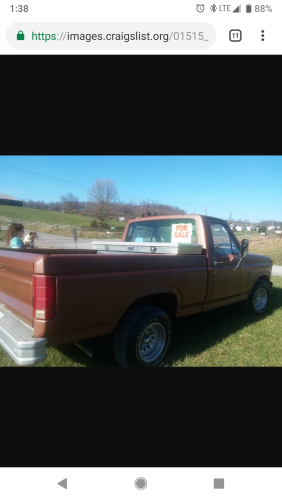 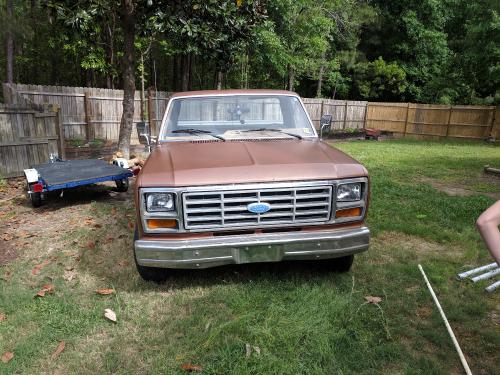 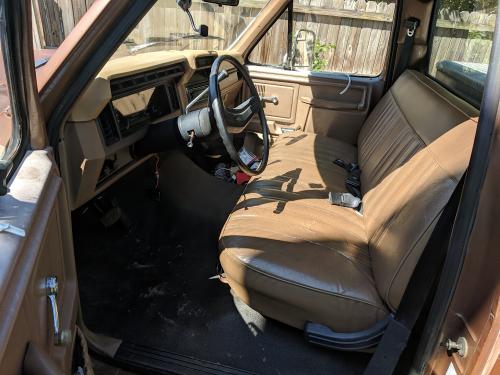 
1985 F-350 XL | 460 | C6 | "Rufus Maximus"
1986 F-150|Standard Cab|4x2|300Six|C6Transmission w/3.08 rear|Name:TBD 2021 Ranger XLT Super Crew | Cactus Grey | black out package | max tow |
Re: "Hook 'em Up Loose" - 1986 F-150 Restoration/build
|
Administrator
|
That's a nice looking truck. And alternator problems are fairly easy to fix. And you really did come in on a wing and a prayer!
But rust? Yipes! What parts are you looking for? On the windshield, if you haven't replaced it be very careful when you do. The VIN moved some time after '86 and most companies want to install the later windshield. But the mask is wrong and you can't see the VIN. In fact, you have to remove the dash cover and use a mirror to read it. That can be a real problem when you sell the truck. Don't ask. Anyway, I'm along for the ride. 
Gary, AKA "Gary fellow": Profile
Dad's: '81 F150 Ranger XLT 4x4: Down for restomod: Full-roller "stroked 351M" w/Trick Flow heads & intake, EEC-V SEFI/E4OD/3.50 gears w/Kevlar clutches
|
|
In reply to this post by Danny G
Step one - Addressing the monkey in the room, the charging issue.
In the way home I had both the battery and alternator bench checked. The alt failed on the truck but passed on the bench. Being an aviation guy with a background in electrical I immediately suspected bad wiring. I noticed some shoddy work on the harness between the alt and the starter contactor (selenoid/switch whatever floats your boat). And some bad fuse links etc. Those were the first to be replaced. Every wire repair I did was done with serviceability and longevity in mind. Every splice and connection was environmentally sealed, heat shrink, labels applied for connections and splices etc.
The old fuse link looked like this:
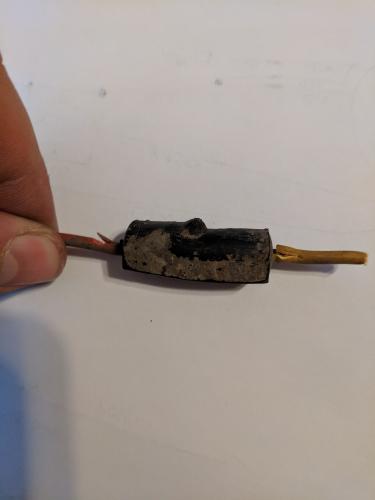 I found a lot of bad cuts into the harness and corrosion from poor troubleshooting practices and more importantly poor restoration of the harness after those practices. It all got replaced. After that the truck.idled and output was up around 13.5 at idle.
I found a lot of bad cuts into the harness and corrosion from poor troubleshooting practices and more importantly poor restoration of the harness after those practices. It all got replaced. After that the truck.idled and output was up around 13.5 at idle.
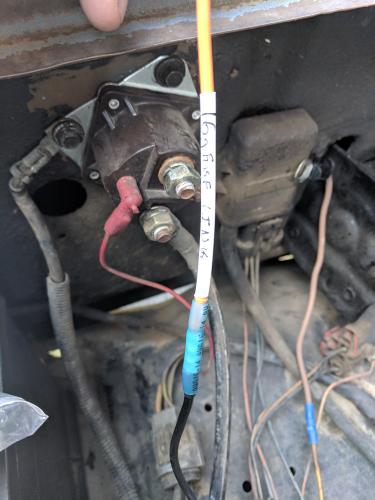
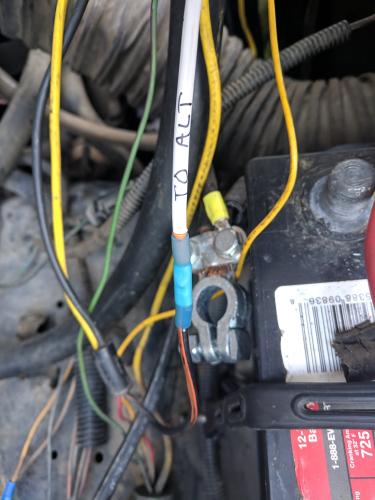
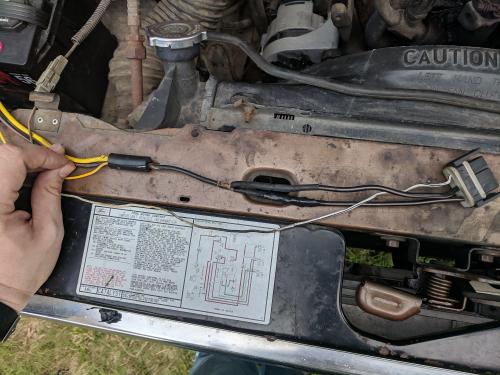
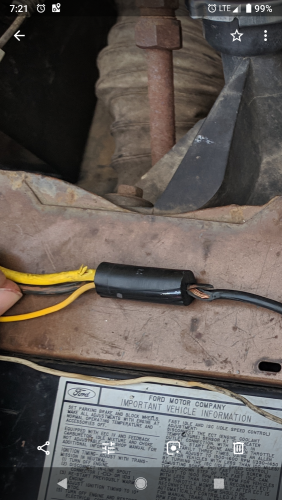 Damaging this jacket allows water to flow into the splice. The splices are molded so you can't see what's going on corrosion = impeadance.
Damaging this jacket allows water to flow into the splice. The splices are molded so you can't see what's going on corrosion = impeadance. 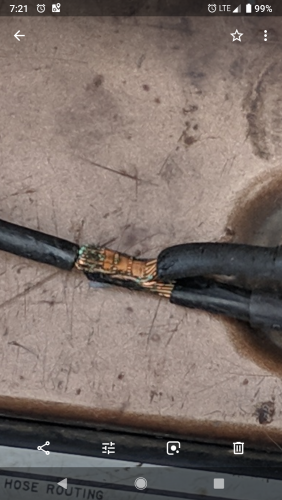 
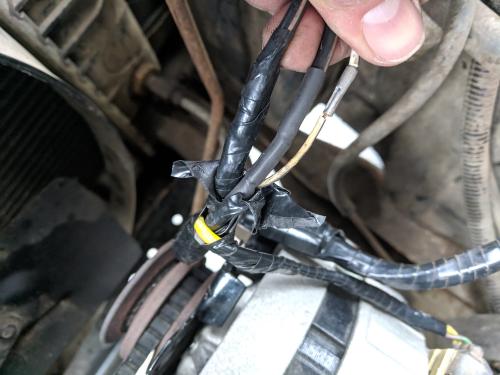 Rebuilt harness, voltage at idle went from 12.4-12.6 to 13.55v.
Rebuilt harness, voltage at idle went from 12.4-12.6 to 13.55v.
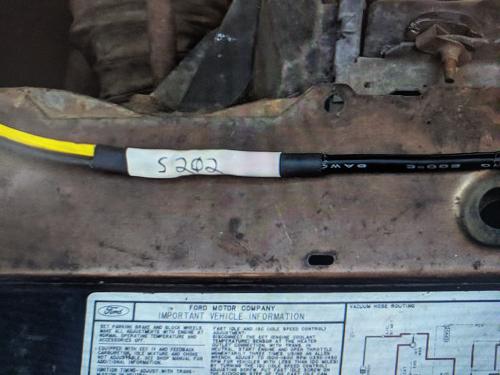
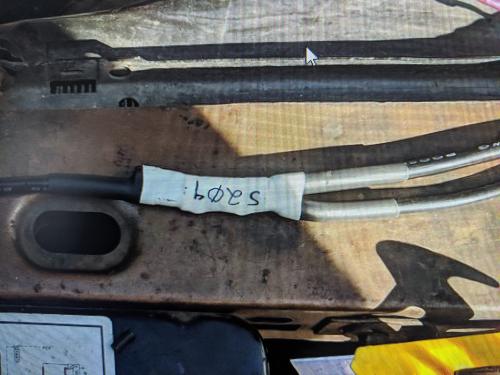 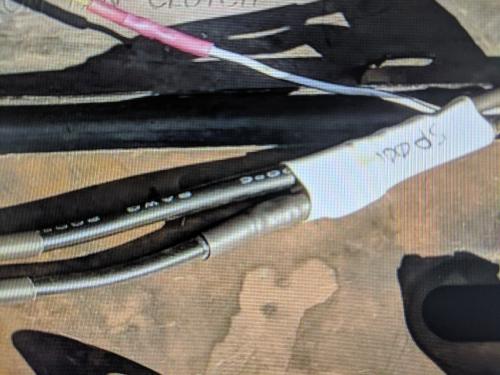
1985 F-350 XL | 460 | C6 | "Rufus Maximus"
1986 F-150|Standard Cab|4x2|300Six|C6Transmission w/3.08 rear|Name:TBD 2021 Ranger XLT Super Crew | Cactus Grey | black out package | max tow |
|
I'm going to type this on the computer and then probably just edit in the pictures from ye olde phone.
After I handled the charge issue, the next issue was it dying when putting it into gear or hitting the gas. It would die. With some help from snooping this forum and talking to the guys at the FTE boards we settled on vacuum issues. And boy did we find... many. The big one being the charcoal canister being unhooked but also found several on the "tree" behind the carb just unpluged. Part of my reason for the 300 six was its reputation as a simple, durable engine that will be left running when its just cockroaches and fall out left. My favorite quote is from a guy I was talking to about his truck, in short he said he could throw his 300 off the golden gate bridge, fish it out 10 years later and it would crank up and go to work. My friend has the sister truck to mine. Built on the same factory line in VA in the same month of the same year. Mine was chestnut, his was Blue, but in rough shape and no AC. He pulled that truck from a field where it had been sitting for more then a decade, hit it with some fresh gas and ether and drove it out of the field. My dad had the EFI version of the engine and the only thing that ever went bad was the thermostat. With that said, part of the allurement of the 300 was it was mechanical and simple. I have never timed an engine etc and still need to learn BUT this is where I learned the truck has a computer.... queue shocking music. I am focused on getting the truck restored and running to factory specs so I have clean slate knowing what is what. Modifying something like this when it already is out-of-sorts will just inevitably lead to head pounding frustration. I think my future plans included deleting the computer and reverting to mechanical only function. I worked to plug all the holes and replaced bad vacuum lines with new silicone lines. I found these extra hoses on my carb, I think the previous owner may have replaced it with he wrong carb. I have yet to fully understand where these lines go on my feedback operated engine. 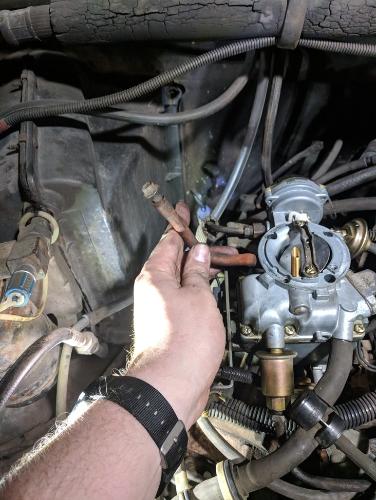 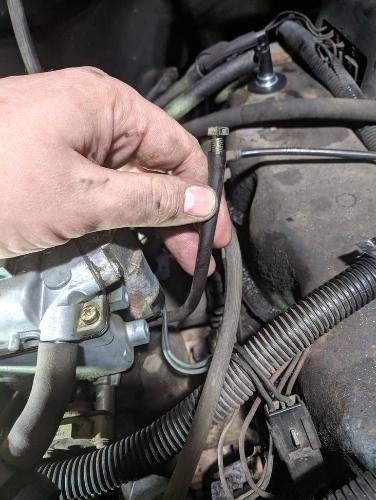 A couple of the silicone lines are visible here. I bought them to color code to the diagram on the core support. Everything is also getting high temp sleeving for added protection and to tidy up the engine compartment. I may splice out and rewire the compartment so everything runs down the fenders and fire wall in the future. Maybe add some water tight plugs instead of splices and make a patch harness which would allow for easier future modification or restoration and troubleshooting. Working down the wire harnesses to check their status I found some troubling issues. I cannot remember off the top of my head if this splice goes to the coolant temp sensor or the AC compressor. The previous owner had the AC compressor disconnected because supposedly it didn't work. I don't know why he just didn't leave it off but I am sure ill find out when I get to that point. Using the EVTM off this website I identified it as splice 276. So off to work I went, adding a bit of wire, fixing the splice and sleeving the lot when satisfied. 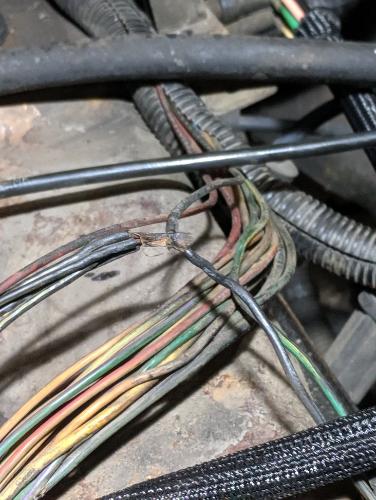 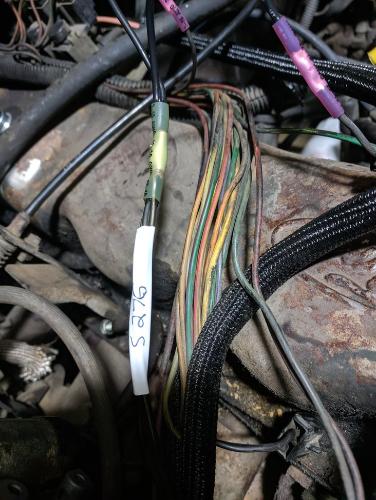 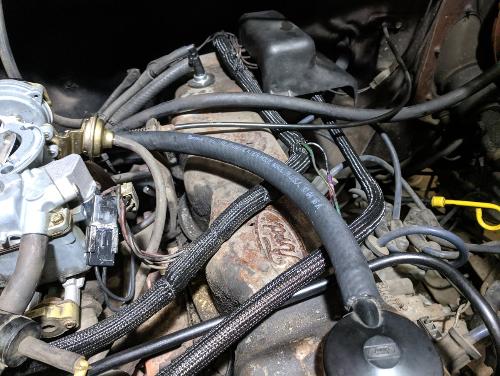
1985 F-350 XL | 460 | C6 | "Rufus Maximus"
1986 F-150|Standard Cab|4x2|300Six|C6Transmission w/3.08 rear|Name:TBD 2021 Ranger XLT Super Crew | Cactus Grey | black out package | max tow |
|
I guess the next logical step in this catch up thread is the air cleaner. I am lucky enough to still have the hose from the intake box and also have the metal heat plate along the manifold. The air cleaner I feel like is wrong though, like not original to this model. You will see a picture of it with hoses on it after i cleaned it up that im sure is not right the sensor on the side is not on my vacuum diagram. my diagram shows a hose from the flapper, to the bi metal valve on the top then to the vacuum tree behind the carb.
Areas of concern. I had oil in my air box. The filter for the hose running to the breather was soaked in oil as well. The PCV was oil soaked and the breather and breather hose oil soaked. The valve cover was also loose enough I could take the bolts out by hand. I removed the breather and tried to clean it up. I got nothing but bug parts non stop out of it. Two cans of cleaner later I exceeded the part value and was still getting junk out of it. I ordered a new stand alone breather filter. Removed the PCV it was moving but slowly. Chucked that one cleaned up the hoses and put a new pcv in. The bi metal valve was toast, rusted closed. I already knew what I wanted on this breather... I ordered some Ford Blue and black duracoat, found a NOS bimetal valve on ebay and went to work stripping the box down. 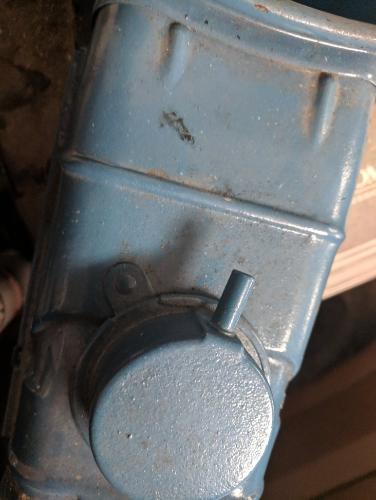 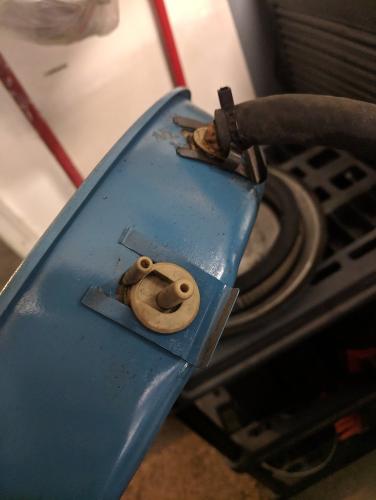 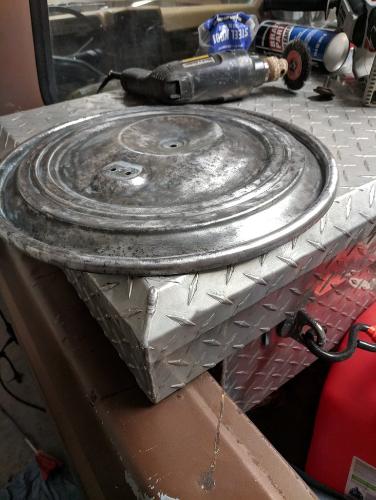 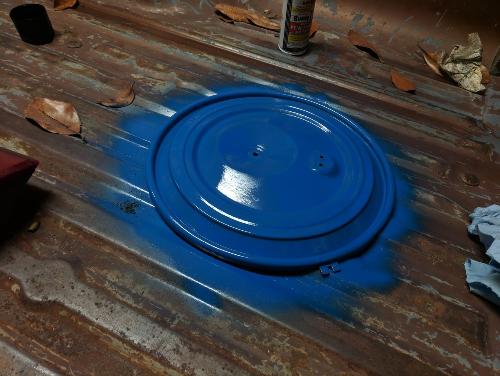 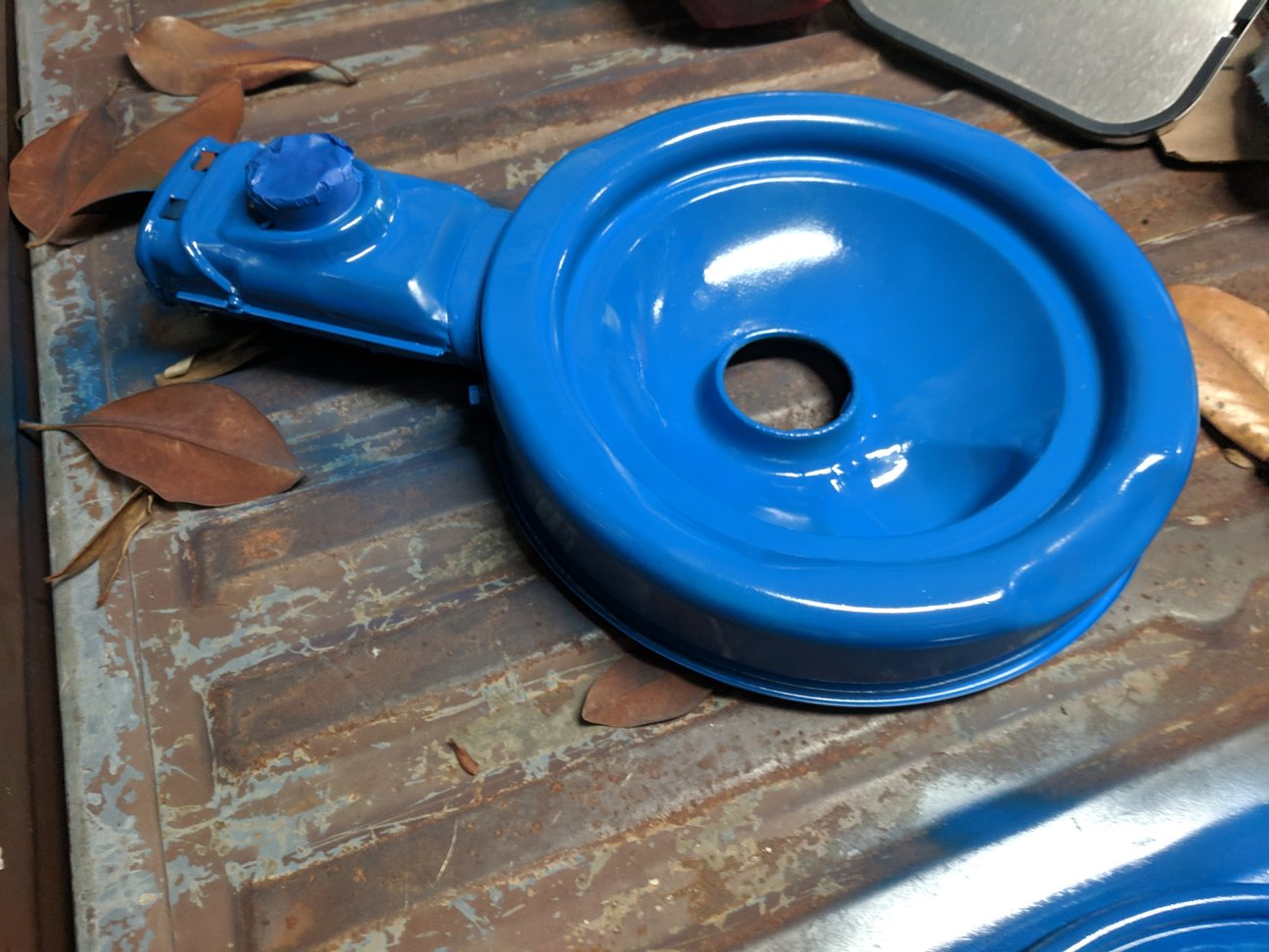  While I was at it I was changing V belts and replacing the leaking thermostat housing and thermostat. Decided it needed a coat of paint to. It was too seized up to get apart so I bought a new elbow, housing, stat, gasket, and sensor. It doesn't hurt to replace old parts with new ones, especially if they are cheap. it gives a piece of mind aspect, and for me... I hate doing things twice or taking things back apart to get to something else. This is why the interior went full bore when I just needed door seals and seat belts to make it driveable, hence the specific mechanical work I was starting with. I just wanted to drive it for now. Well that didn't pan out. With that in mind every step of the process is treat rust as we go. That includes the bolts. Each one that came off got cleaned up, treated and painted. 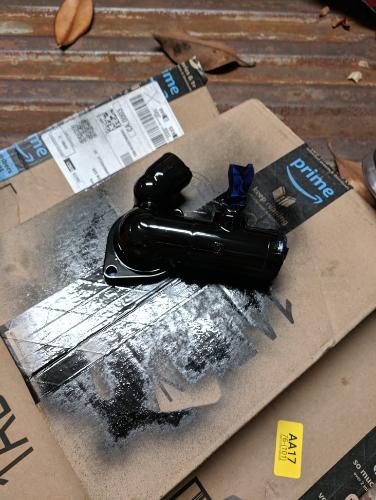  Next bit of inspiration came when digging around I spotted the Ford script on the valve cover. So off she came. The old cork gasket was in three pieces... yep.. the PO definitely replaced this... Stripped it down and sealed it with corroseal, and made what I visualized come together. Some Aluminum color and black duracoat. It was not until after this I learned a few hard lessons Corroseal is not intended for high temperature areas and the brush strokes will show through... but I don't think you can really sand it because it would seem reasonable you would void any rust protection it offered. IF YOU CAN sand it someone let me know. If not in the future ill use it in spray or roller application. 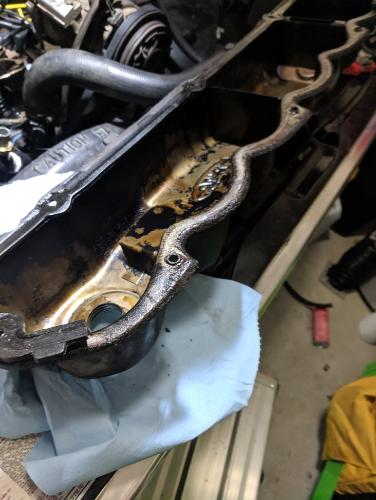 You'll notice I already did wires and rotor cap and plugs. This was part of the prompt to pull the Valve Cover as I found some oil on the rear plugs. I also found that when cyl 1 is TDC(best i can tell) the rotor points to the factory location for cyl 5. So i relabeled the cap. This kind of thing will drive me a bit OCD and I don't fully understand timing and how all this works yet. But once I am back to working on the engine I am going to want to fix this so the rotor posts are in he right locations per the manual. 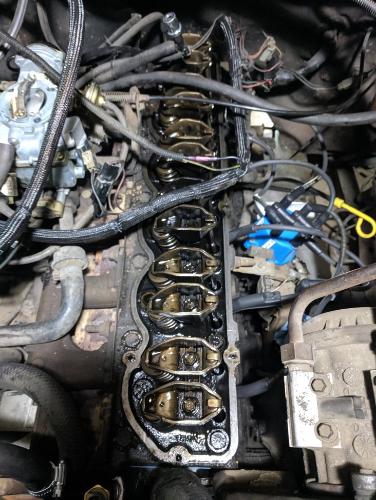 Super clean is some great stuff and cheap. Using it straight will strip paint and the grease off of this cover. This cover was originally gray and had the ford part number label on the back still. 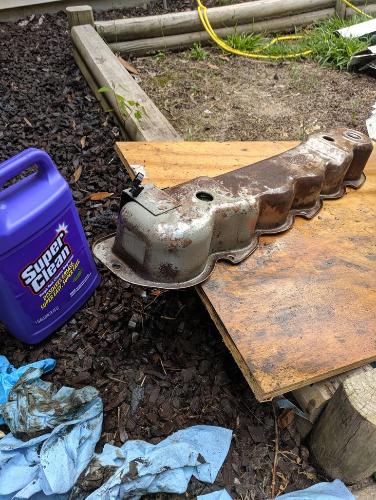 lots of brush work to get the rust out of all the nooks.  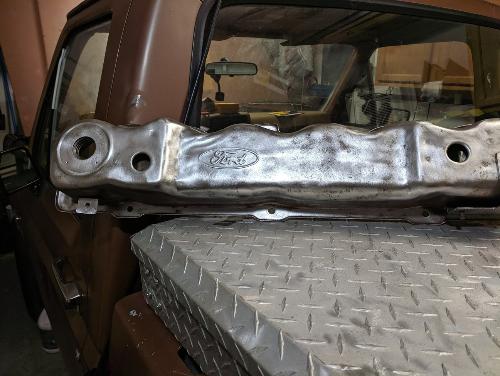 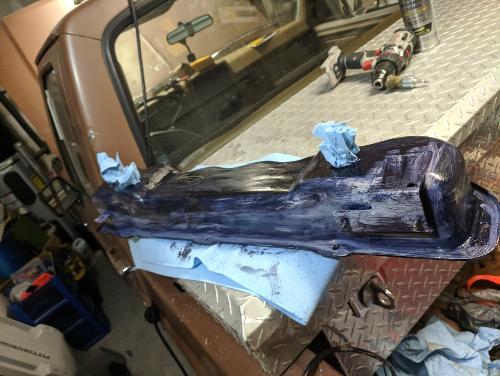 Its time to make that inspiration a reality, and my 3yo son decided he wanted to help. Painters tape, an Xacto knife and a boneing tool from my leather working kit to make this work.  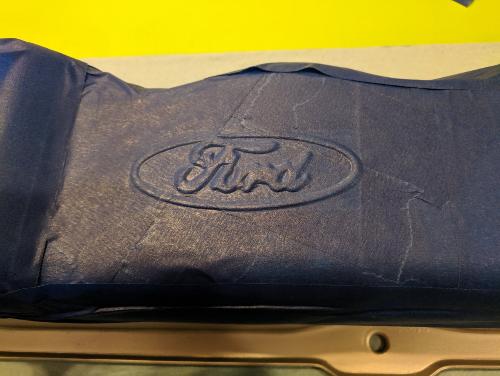 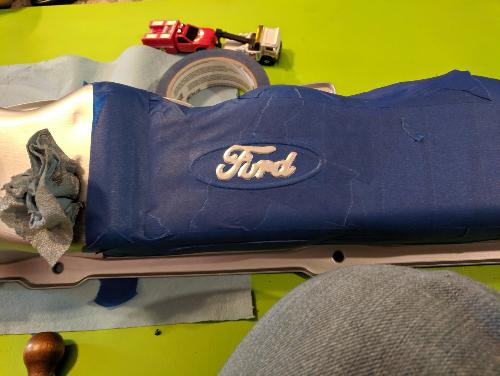 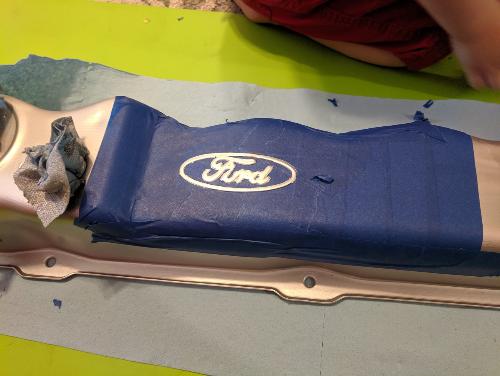 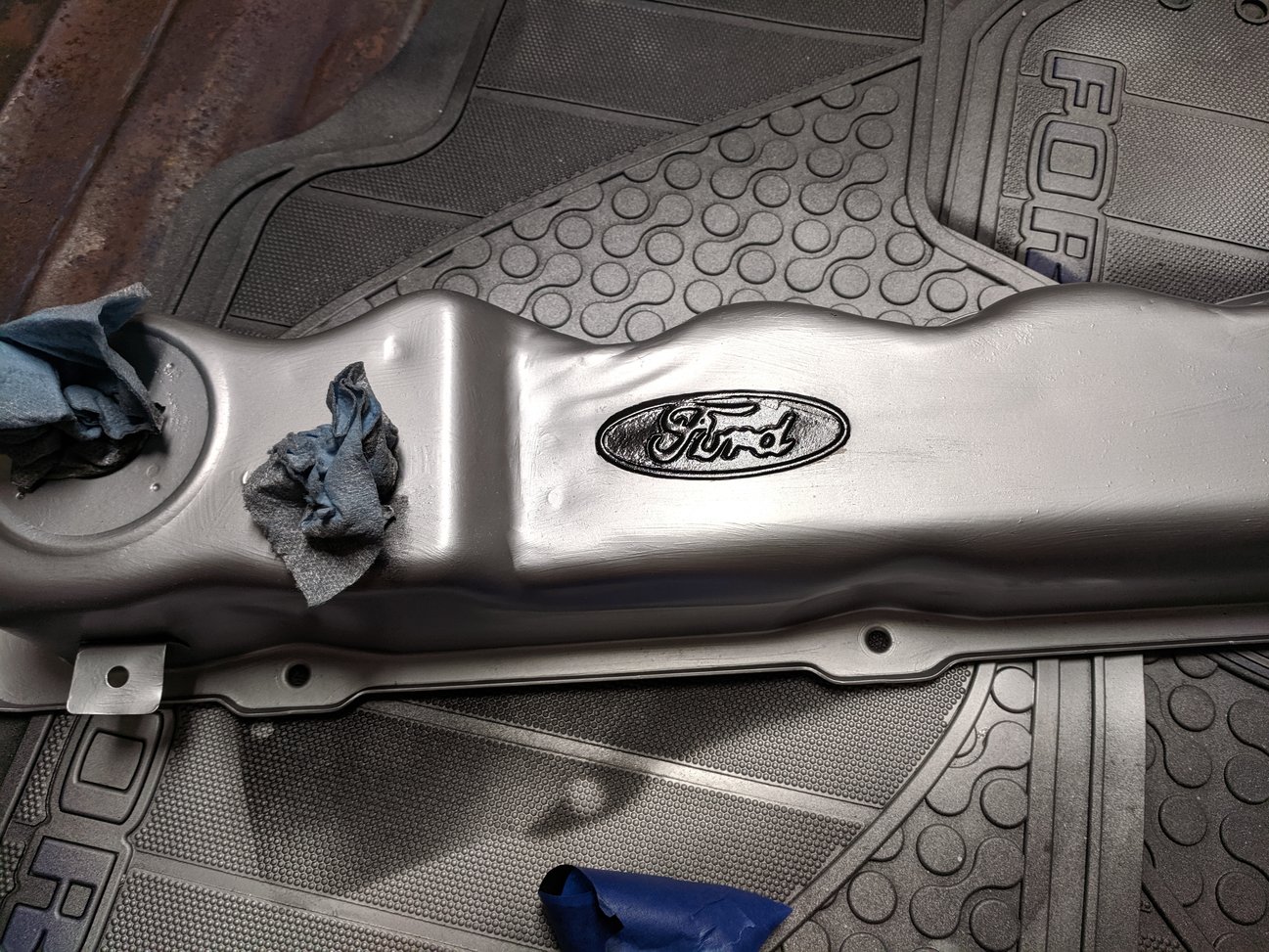 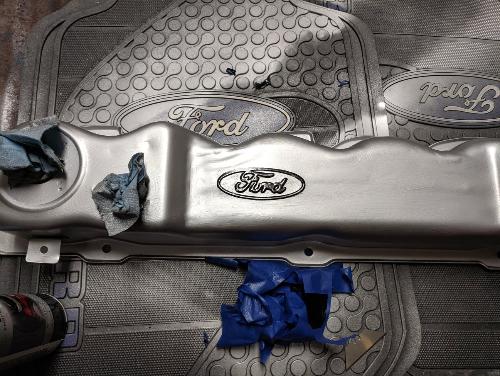 a little minor touch up with a detail brush and its right as rain.
1985 F-350 XL | 460 | C6 | "Rufus Maximus"
1986 F-150|Standard Cab|4x2|300Six|C6Transmission w/3.08 rear|Name:TBD 2021 Ranger XLT Super Crew | Cactus Grey | black out package | max tow |
|
Valve Cover goes back in.
The gasket was a Mahle rubber/cork with metal carrier. Very easy to work with, no flopping around. Installed with the ever excellent Permatex No. 3 Sealant, not gasket maker. I am almost positive this is why the water outlet gasket failed. The previous owner installed it with a die cut gasket that had permatex gasket maker on both sides. Paper gaskets and permatex don't really mix IMHO, use one or the other. The paper gasket separated between the gasket maker and leaking ensued. I think people also don't think about squeeze out. The amount of sealant you need is very very minimal on aircraft we put that thin, like half the thickness of a credit card. And even then you get squeeze out. But with squeeze out its going to push all directions available which means INSIDE your engine as well as out. If you see a bead on the outside, you can bet your paycheck there is an equal amount on the other side of the mating surface. But you just used Permatex sealant... yep it is not gasket maker its gasket sealer, it does not dry, and I put it on thin. Where gasket sealer flexes and peels over time, gasket sealer allows he gasket to do its job while filling any imperfections, it does not peel. 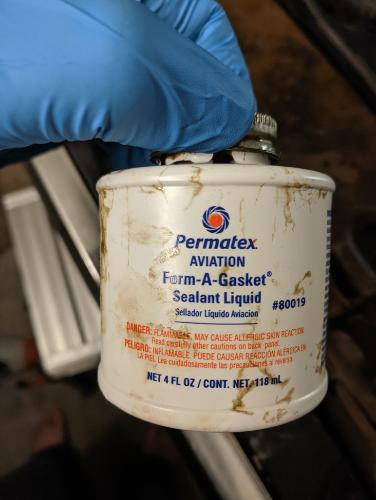 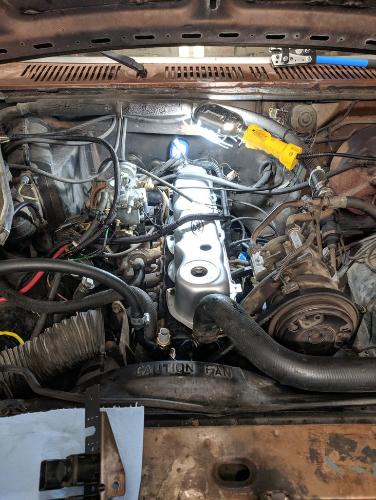 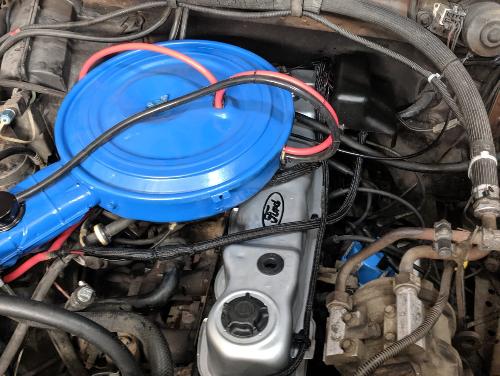 That Spectre oil cap has got to go. I ordered one that has "OIL" and the bottle on it. New grommets installed for the breather filter and pcv. The entire engine bay, wire harnesses around the lights etc have this thick layer of gunk... i think its from oil? I am not sure, it has definitely preserved the integrity of the truck, but I am worried why it is here in the first place. 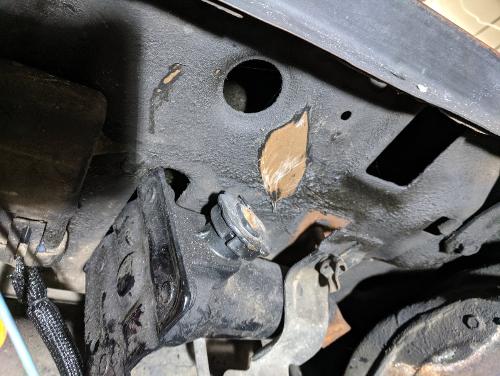
1985 F-350 XL | 460 | C6 | "Rufus Maximus"
1986 F-150|Standard Cab|4x2|300Six|C6Transmission w/3.08 rear|Name:TBD 2021 Ranger XLT Super Crew | Cactus Grey | black out package | max tow |
Is it perhaps mildew? After parking my truck outside for most of the last 5 years I had an amazing layer of mildew in the engine bay, although in my case the worst of it was on the underside of the hood. Ten minutes with the pressure washer and things were MUCH improved. |
|
In reply to this post by Danny G
Making a new fuel line.
The fuel line between the pump and the carb was bent out of shape pretty bad. I rotated the fuel pump top a little struggling to get it off. Time to learn a new skill... pipe bending. Bought a straightener, fittings, pup, cutter, flareing tool... that failed then bought this inline flare tool, and bender and started learning lessons. After scrapping a couple runs of pipe for silly mistakes I finally got my new fuel tube bent. There are correction factor formulas for bending tube 90 and 45 degrees. I am working with 5/16 tube so my 90 degree correction factor is 0.297". Basically you measure all your centerline's and then multiply .297 by the number of 90's then add that to your centerline totals. Then add extra to that for your overall rough cut length. I'm working with coiled tube so I want extra for goof ups, but also after straightening, the ends of the tube should be cut off about an inch back to be sure it is as straight as possible. Tools and Materials -5/16 tube -Flare fittings -Double flare tool capable of bening your pipe -Debur/chamfer tool or cogsdill if you have one. -5mm allen socket and 3/8 ratchet (for setting up my flare tool) -Wire brush for cleaning out the flare tool grip -Rule (lost mine used a measuring tape instead but a steel rule is best) -wrench for the fittings and flare tool -tube straightener -vise -tube bender Pencil or sharpie 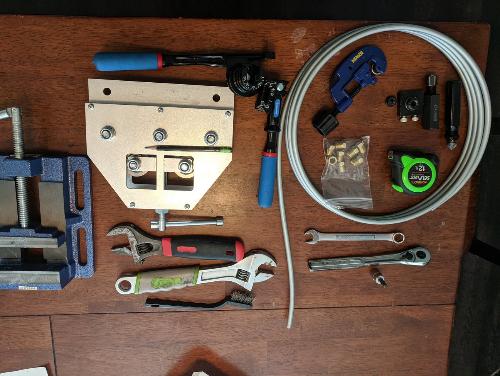 Uncoil and rough measure your tube and begin running it through the straightener, rotating as necessary and adjusting pressure until the tube is straight. Then cut off about 1" from the end and debur/chamfer. You will probably see some minor bends at the end of the tube here you can't pull out, this is why we are whacking off an inch or so. 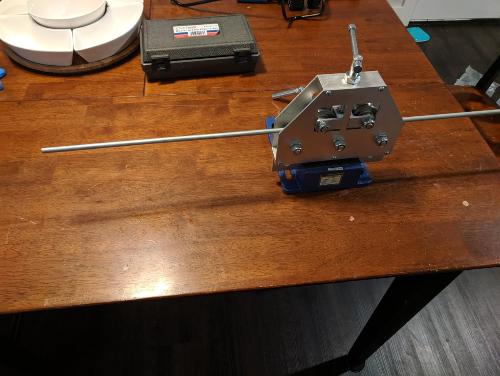 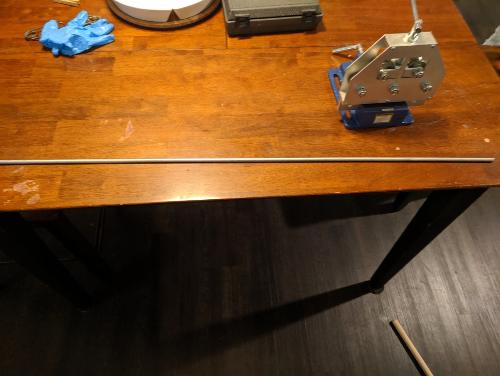 Make the first flare and install the fitting. I chose the end that hooks to the pump because it was the longest first run and allowed me to have room to make the first bend without having an interference with the fitting. Do not forget the fitting. If you make the first bend after the flare, start over, you won't get the 90 out. "But I'll just do the fittings last..." Yes you could do this but having one done allows us to dry fit the tube in the truck as we go to check alignment. Before you start making the flare use a pencil or sharpie to mark the back of the tool. This will allow you to see if the tube is slipping excessively and stop before you get to far. After the flare is done use the brush to clean out the flare too grip area. Inevitably some metal shavings will be here. Making another flare with these in place can damage the tool. 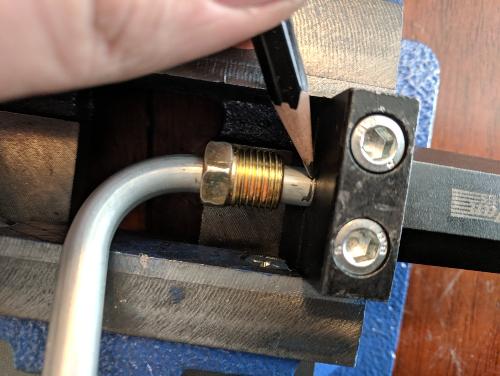 (Picture is of my final flare) Measure your first centerline and mark the tube on what will be the outside curve of the bend. If you mark the tube this way, you will always bend the tube in the correct direction especially on those bends that do not intersect the tube plane at 90 degrees. The final bend that goes to my carb is like this. It is a 90ish degree bend that intersects the tubes plane around 55 degrees. My tool was not capable of making two 90 degree bends 1 3/4" apart like the factory tube. I destroyed my first tube by flattening the previous 90. To make up for this I had to make this part longer by 5/8" then compensate on the length of tube going the other direction. 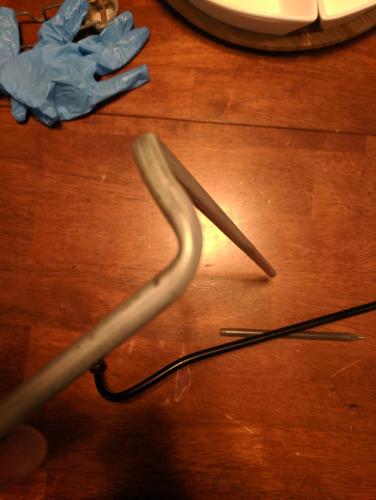 Dry fit the tube after each bend (this is why the first fitting is on.) So you can gauge if anything is off it also helps to compare to the original. This last bend is one where marking the tube on the outside curve of the bend and dry fitting both help you make sure you are heading in the right direction. You can bend tub more, but going back after a significant bend is not gonna happen. You can also take a scrap piece of pipe and install it on the fuel filter here and use it to mark the point where it intersects the new tube.  Additional bends were made. And a little hand adjustment to get the tube just right. Use a fitting to check final alignment. 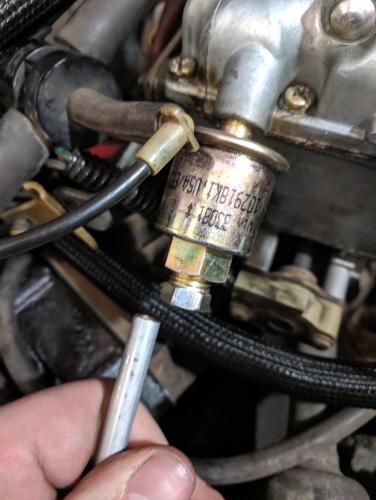 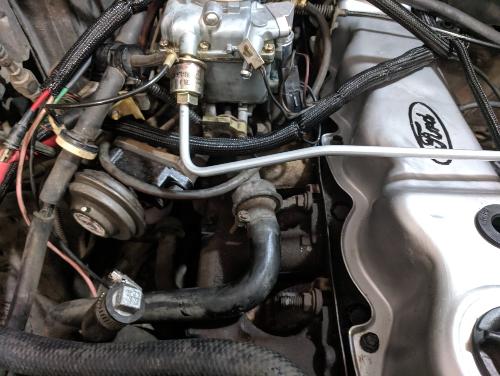 Before you make your final cut do not forget to compensate for the flare. Measure your centerline then add in the flare adapter length, then cut. Once you have that make the final cut and dry fit one last time. Then do the final flare and go put her on. I took it off and gave her a good coat of black paint, cant seem to find that picture right now.
1985 F-350 XL | 460 | C6 | "Rufus Maximus"
1986 F-150|Standard Cab|4x2|300Six|C6Transmission w/3.08 rear|Name:TBD 2021 Ranger XLT Super Crew | Cactus Grey | black out package | max tow |
|
In reply to this post by Dorsai
That is an interesting thought, I have seen truck here with mildew and algae. But its almost like tar.
1985 F-350 XL | 460 | C6 | "Rufus Maximus"
1986 F-150|Standard Cab|4x2|300Six|C6Transmission w/3.08 rear|Name:TBD 2021 Ranger XLT Super Crew | Cactus Grey | black out package | max tow |
|
Special internet high five to anyone who can tell me what "Hook 'em Up Loose" means and where it came from.
1985 F-350 XL | 460 | C6 | "Rufus Maximus"
1986 F-150|Standard Cab|4x2|300Six|C6Transmission w/3.08 rear|Name:TBD 2021 Ranger XLT Super Crew | Cactus Grey | black out package | max tow |
|
Out with the sponge called jute and vynil. Remember I said it holds water and the screws and caps through the floor weep water into your truck... this is why rockers rot etc.
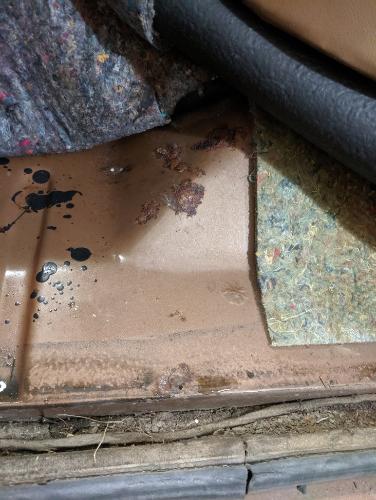 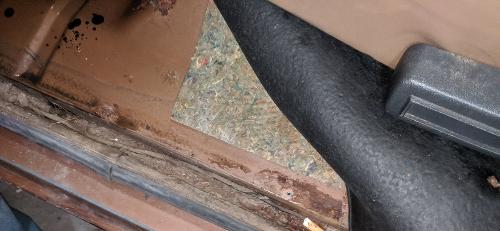 Beginning of a long road of rust hunting and busting. 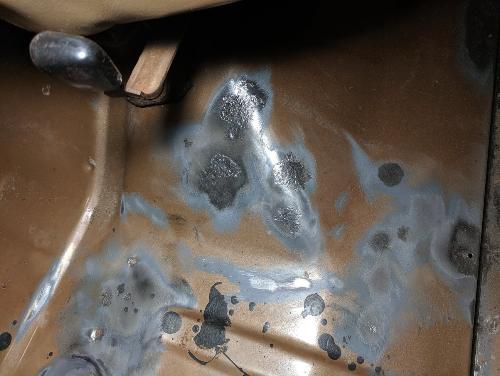 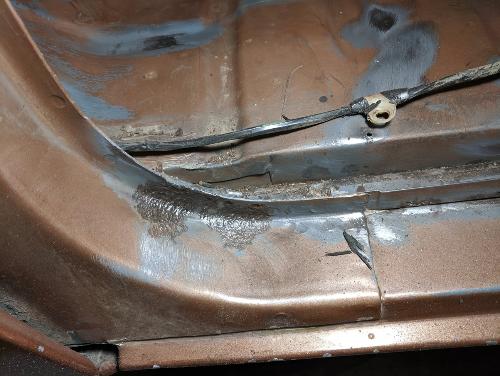 Under that dirt you can see the rocker channel was getting dangerously close to rotting through.  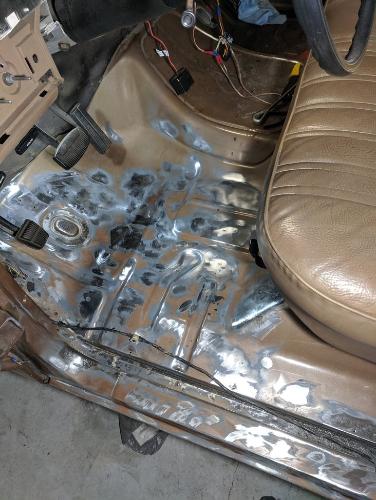 Cleaning up the drivers side cab corners i found some pin holes, these will fill up easy, these were hidden under the paint.  Some rust forming here by the door hinge prompted me to removed them entirely. After they are cleaned up new hinges are going back on and will be fay sealed to the truck to prevent this from ever happening again. 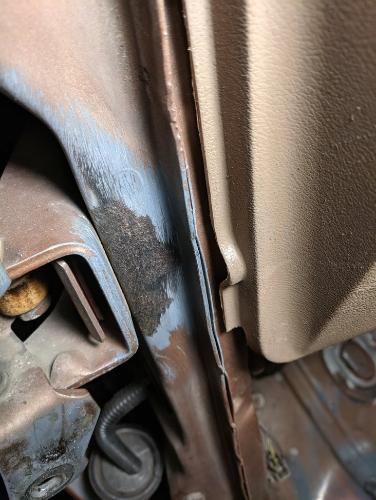 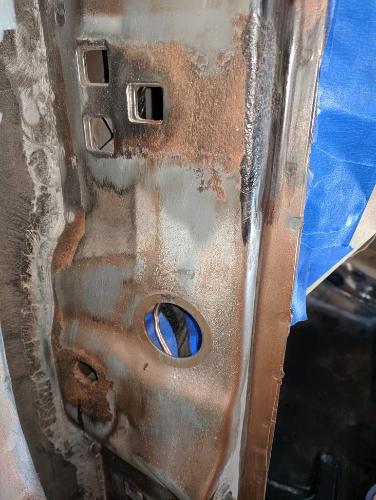  I found a combination of wire cups/wheels and an angle grinder with a flapper disk worked well for cleaning up the rust. I made sure to clear paint well past any rust spots to be sure it was clear. The goal here is never again. Using a flashlight you can see any little "pimples" under the paint. This was 99% of the time rust starting. Corroseal was used to treat the bare metal after it was cleaned well with mineral spirits. I think I would prefer MEK/MPK or industrial IPA as solvent but MEK is very dangerous, MPK is better but you still need the correct ppe to use it as it will soak through latex, and good IPA I don't have a line on so low oder mineral sprits it is. 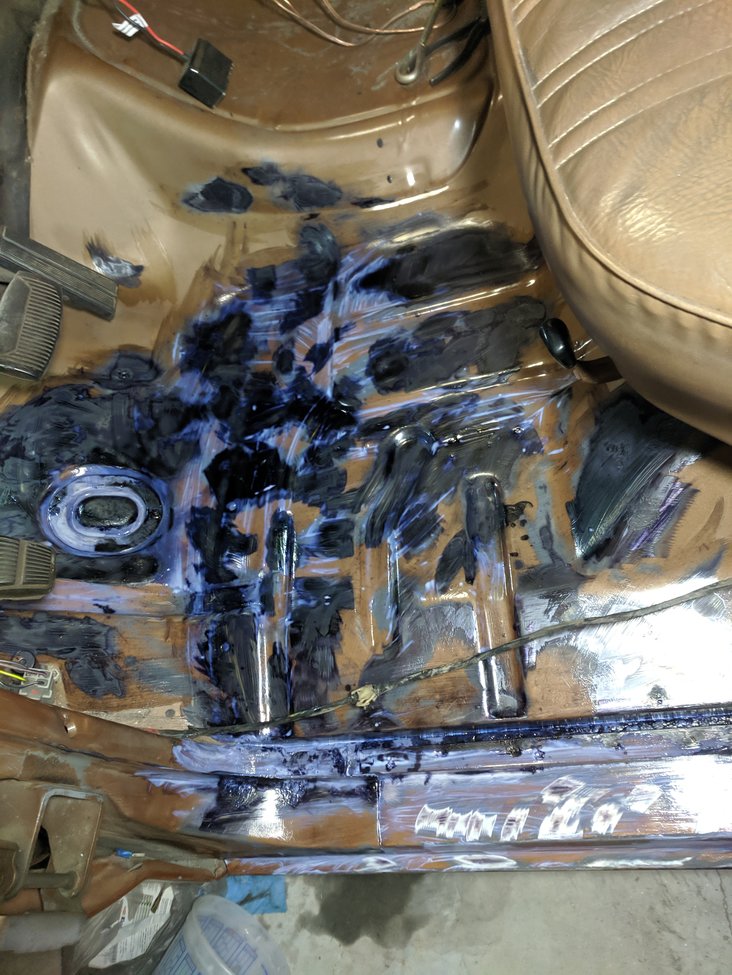 passenger cab corner has some bond 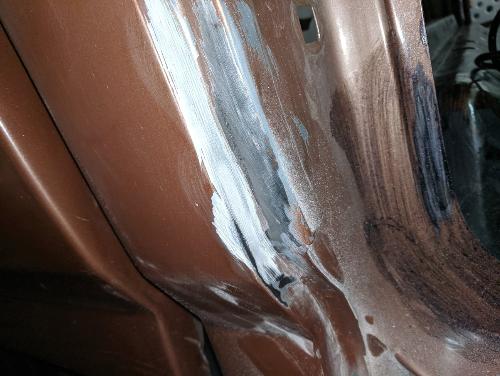 Pulled the truck out of the garage so I could open and remove the passenger door (yes my garage is that tight), and pull the bench. When I did I found a nice puddle of transmission fluid. She is pretty wet all over but looks like at least one is from the pan. Getting add that to the agenda. I will replace this guy sometime, hopefully for 4x4 and something with OD. I thought it had a AOD was surprised to find the C6 but I knew on the way home from driving it either it wasnt going into gear or it didn't have an AOD. 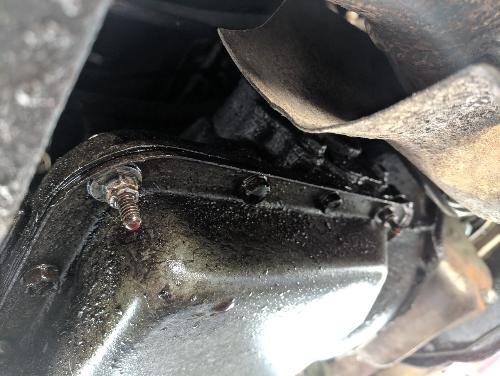 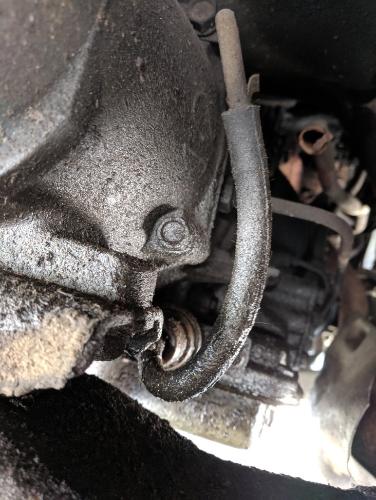 Cat tube gone 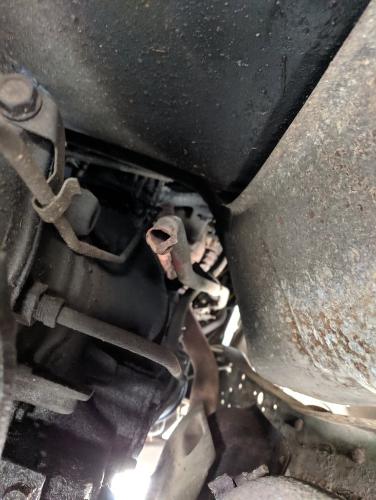 Cab mount rusted through... so much for the PO who has been up and down under this guy. But this is super common, just not something I wanted to deal with. I bought a 120v flux welder and some repair pieces from Jeffs Bronco Graveyard. Will be a new experience there. Maybe one day ill put 240v in the garage and get a tig/mig set up. I have a new generator now that does 240 as well. At the time the 120v flux core welder was my only option. Should do the trick. 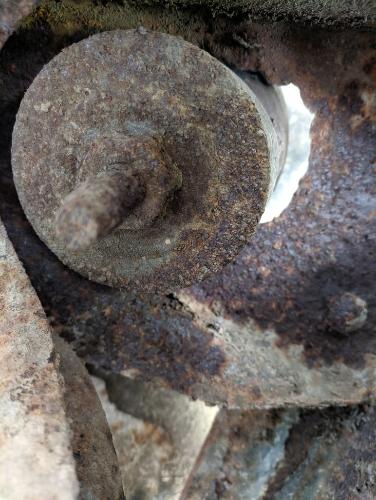 Busting Rust 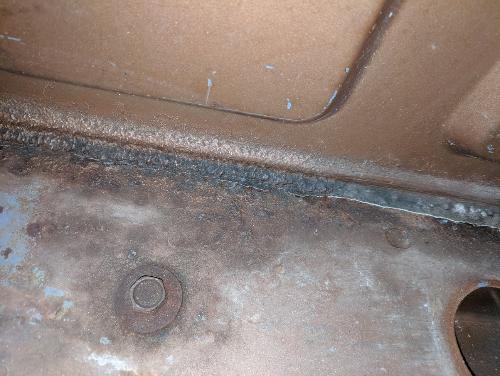 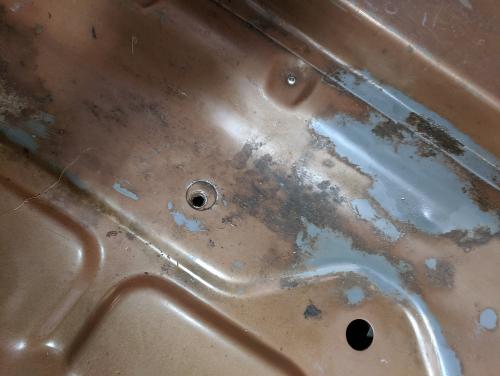 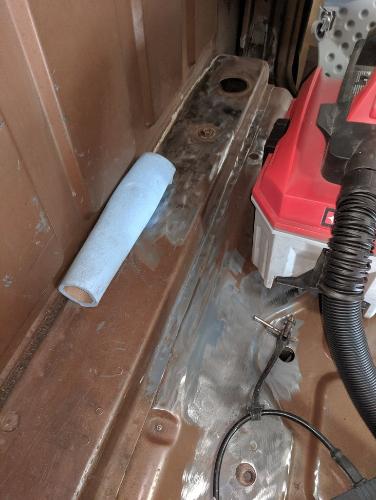 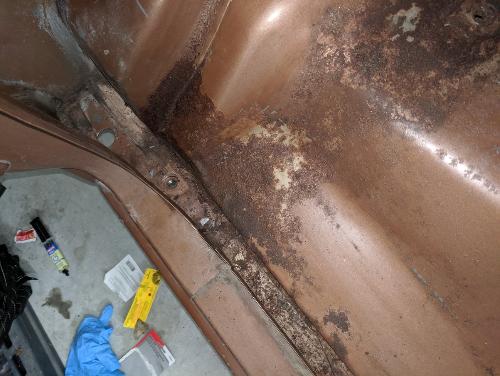 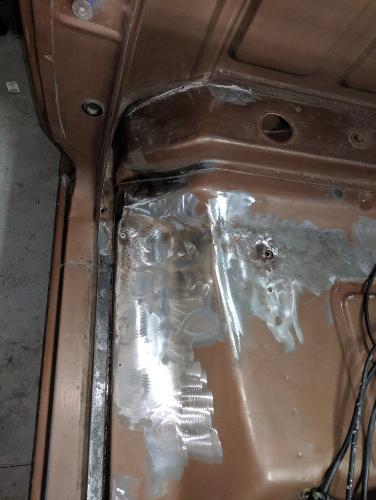 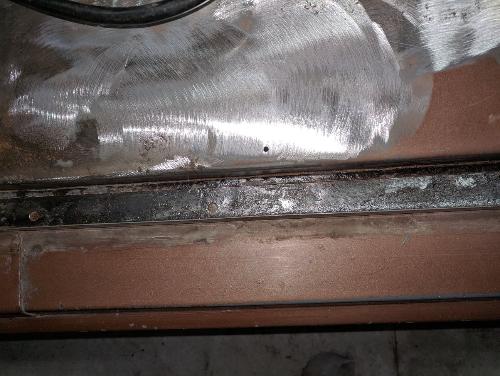 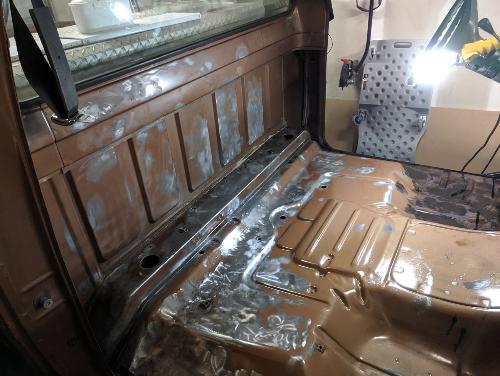 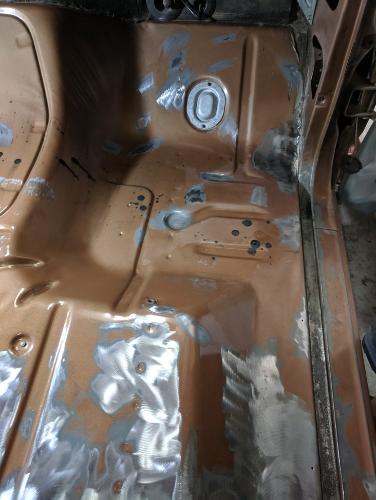 Corroseal turns black in the presence of iron oxide, rust forms instantly when exposed to air just too small for you to see. 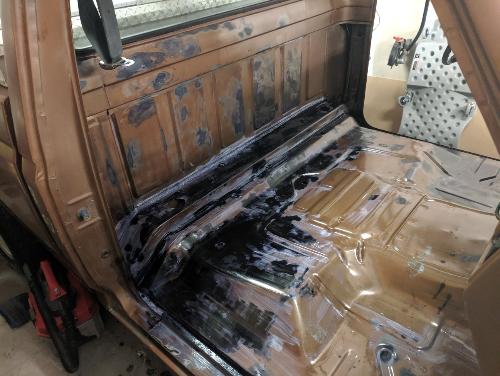 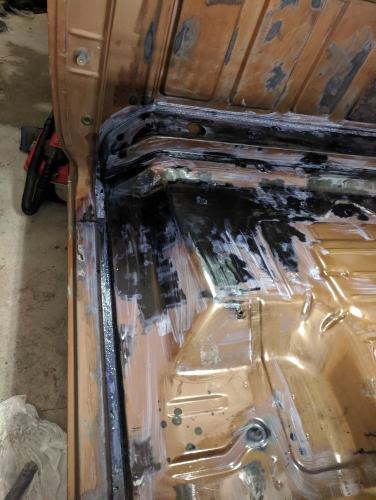
1985 F-350 XL | 460 | C6 | "Rufus Maximus"
1986 F-150|Standard Cab|4x2|300Six|C6Transmission w/3.08 rear|Name:TBD 2021 Ranger XLT Super Crew | Cactus Grey | black out package | max tow |
|
Followed suit with others on the forums and replaced my rollers with some "Ford" blue 1/2" pex. Cut to 7/8" long, split and used the hand dandy Swiss army knife pliers to spread them on. I stall good about 3 seconds with this method. I'm not going to tape them. Curious how long they will hold up like this. Heck I got 5 more feet of pipe. Doors close smoothly, no slamming needed no second push. I can feel some sag on the release so hinge pins and bearings will happen when the new doors get here. Looks to be about a 3/8" drop when the door releases.
 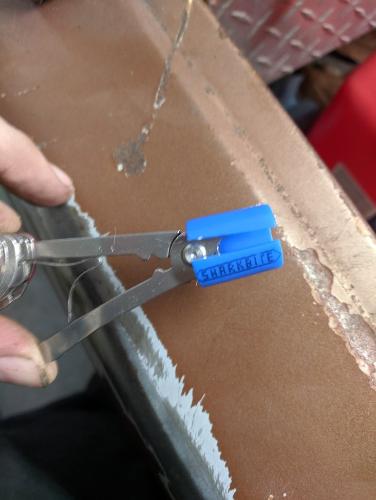 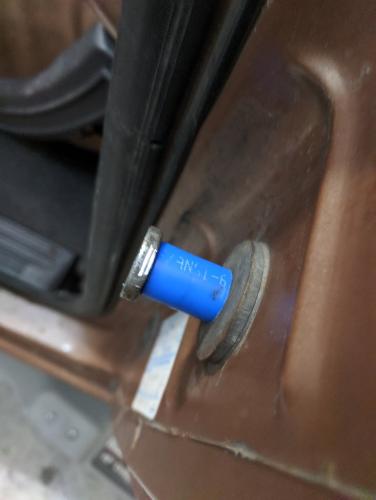
1985 F-350 XL | 460 | C6 | "Rufus Maximus"
1986 F-150|Standard Cab|4x2|300Six|C6Transmission w/3.08 rear|Name:TBD 2021 Ranger XLT Super Crew | Cactus Grey | black out package | max tow |
|
While one thing is curing the next is in work, crawled under the truck to take a look at the frame etc. I was having break scares... like peddle to the floor not stopping scares... I think I found why... look at these lines and fittings. I also tested busting rust, treating and painting on a section of the frame to let it set while I did other work so I could judge how well it holds up. If when I am done with everything else this still looks good I will use that method on the rest. If not... then I didn't waste any time and money.
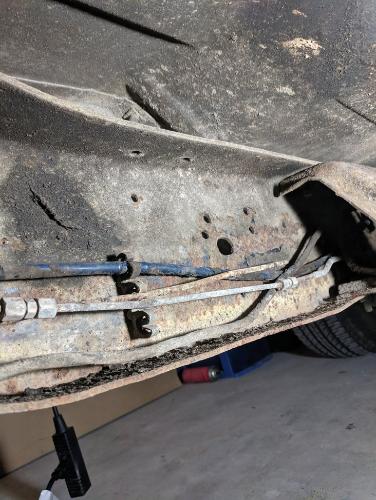 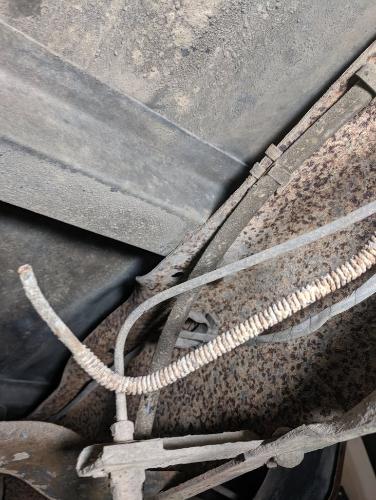 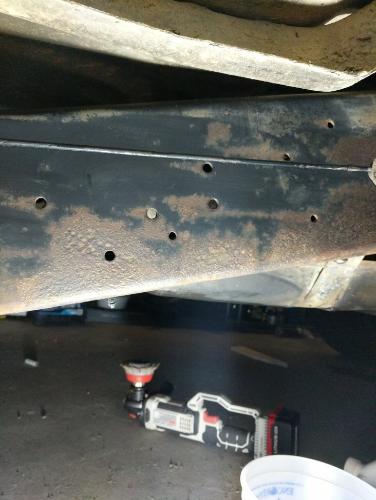 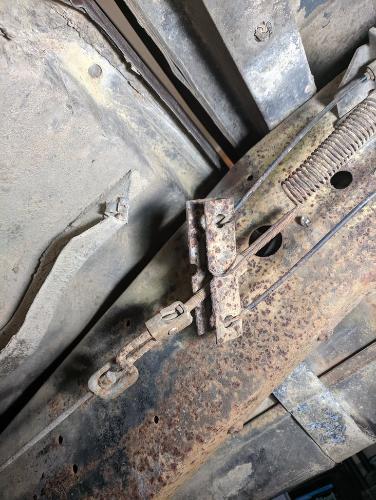 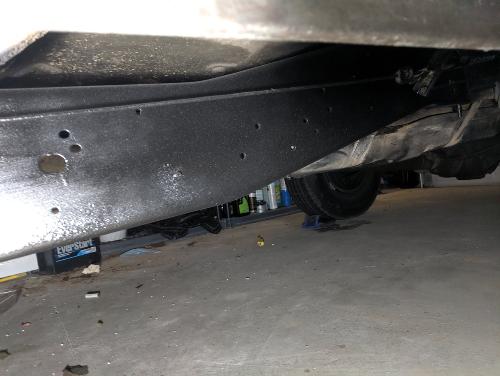 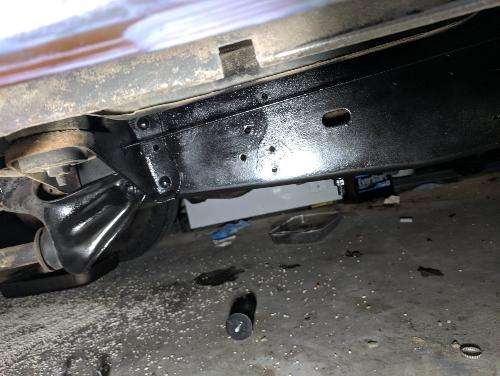 A closer look at the leaks 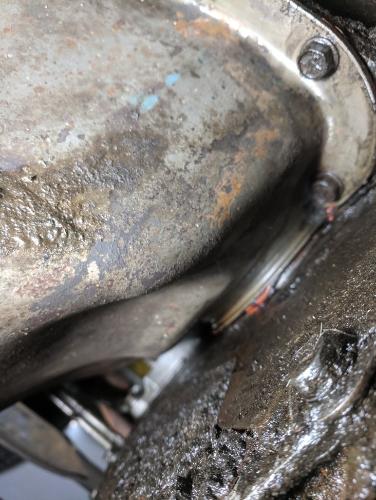 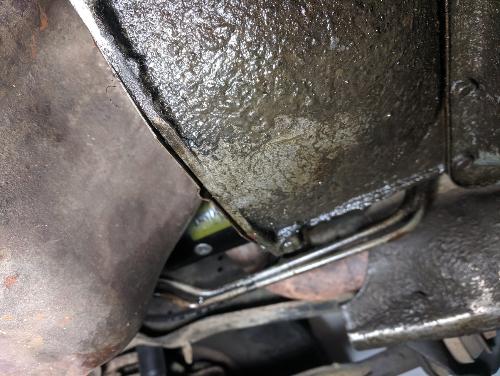 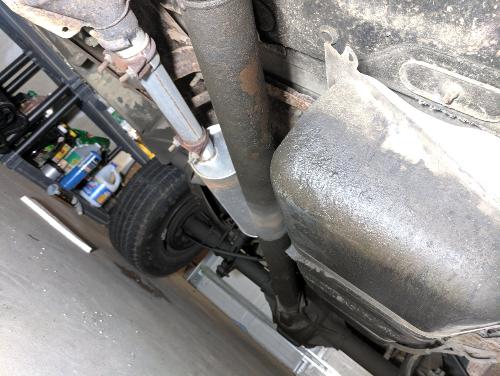
1985 F-350 XL | 460 | C6 | "Rufus Maximus"
1986 F-150|Standard Cab|4x2|300Six|C6Transmission w/3.08 rear|Name:TBD 2021 Ranger XLT Super Crew | Cactus Grey | black out package | max tow |
|
Masked off the rear window dash, pedals and steering wheel. Went over the cab with a vacuum and some denatured alcohol found a couple more trouble spots and cleared the paint.
Laid down another coat of corroseal. I find that two coats at a minimum is needed with this because I'm using a brush. If you let it sit a day or two you will find any "bleed through" when it really is just streaks left untreated by the brush. I experimented with brushing it on and letting it set up a bit then going at it again in a parallel. We will see how that turns out. You know your done when all you have is black from the tannic acid in the corroseal reacting with any ferric oxide.  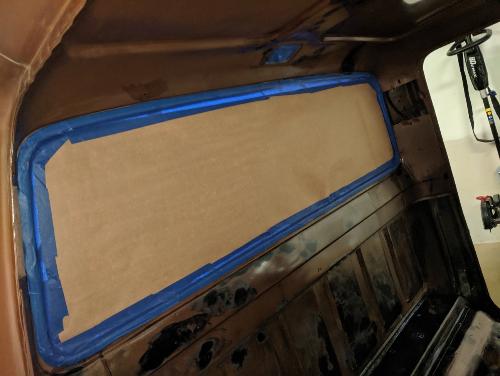 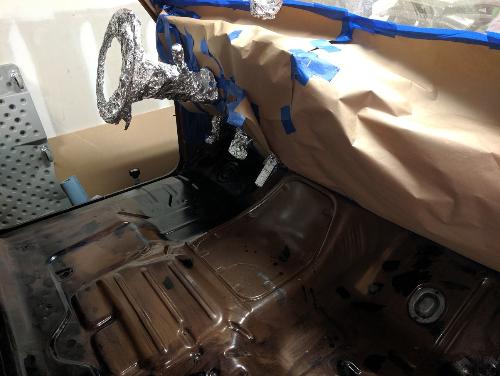 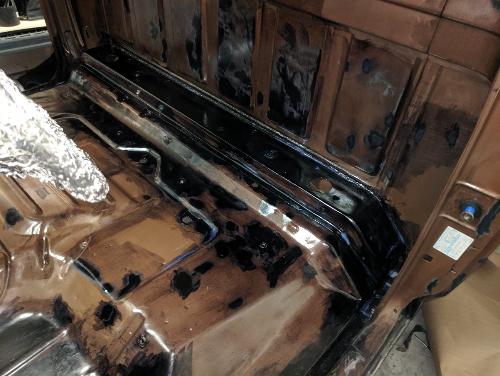 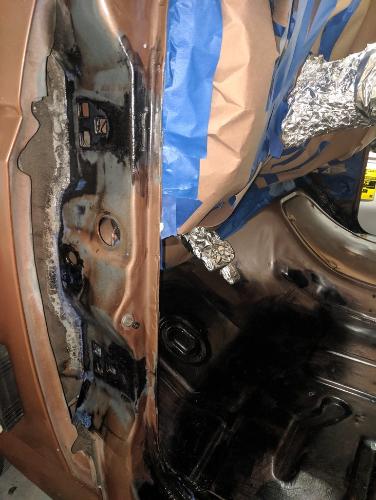 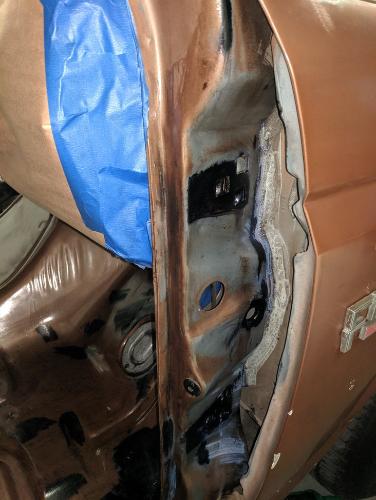
1985 F-350 XL | 460 | C6 | "Rufus Maximus"
1986 F-150|Standard Cab|4x2|300Six|C6Transmission w/3.08 rear|Name:TBD 2021 Ranger XLT Super Crew | Cactus Grey | black out package | max tow |
Re: "Hook 'em Up Loose" - 1986 F-150 Restoration/build
|
Administrator
|
In reply to this post by Danny G
WOW! You've done a LOT of work on this truck! I'm impressed.
 So, are we up to date or is there another raft of posts coming? Just curious where you are in the whole scheme of things.
Gary, AKA "Gary fellow": Profile
Dad's: '81 F150 Ranger XLT 4x4: Down for restomod: Full-roller "stroked 351M" w/Trick Flow heads & intake, EEC-V SEFI/E4OD/3.50 gears w/Kevlar clutches
|
More coming, the interior is almost at the point of going back together. Just ran out of will to keep updating yesterday lol. A friend at work tells me all the time, your doing it right, but no one will ever appreciate the amount of work you are putting into that truck but you.
1985 F-350 XL | 460 | C6 | "Rufus Maximus"
1986 F-150|Standard Cab|4x2|300Six|C6Transmission w/3.08 rear|Name:TBD 2021 Ranger XLT Super Crew | Cactus Grey | black out package | max tow |
|
One of the things I did early on, because little wins are motivational was change out some lights.
My seat belt light was intermittent, several were completely out, map light was out. The side marker/turn signals on the fenders worked, then didn't work(think we have a wire issue). And in combination with the power issue everything was just generally dim. Now a days there is a retro LED bulb for everything. They are not only bright, but they have the added benefit of using less power, meaning that little 2g alternator doesn't need to work as hard, or power could be used somewhere else. Tail lights were easy, picked up LED bulbs on Amazon, and some cheap lenses from Rock Auto. Big difference. 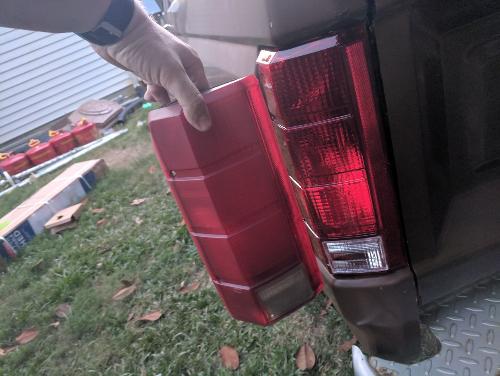 On the front it is just as easy. Being as this is a common bulb size many an option exists. I was hoping to find a set of glass headlights with LEDs but I settled on these ones based on reviews. I used a clear plastic film over the lenses to protect from damage. The housing on the truck was treated for rust before I installed them, I also ended up ordering all new clip nuts and fasteners for the front end as most were rotted away. Turn signal light is the same as on the rear I believe 3157 socket with two prongs. 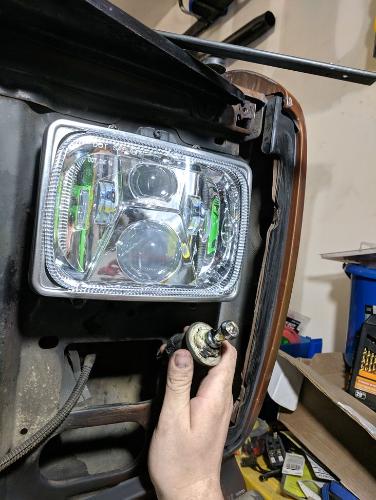 and yes they are bright 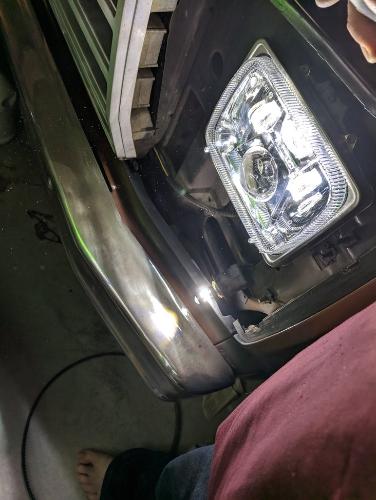 Next was some interior bulbs 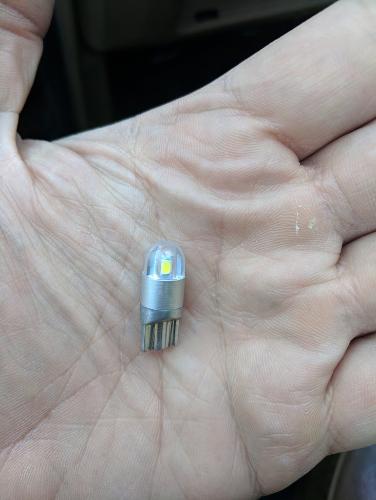 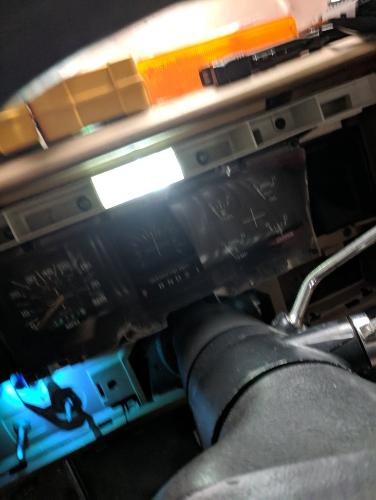 This light was so dim it was useless, now look at it. What is nice about this is if you dont want the traditional back lighting you can take that blue lense out of the bulb holder and buy an LED that is pre colored to what you want. When I lived in TX I worked a lot at night and had to preserve night vision, so my dome light, instrument lights and the entry lights on my mirrors were red. It would allow me to read what I needed to without compromising my vision. If I needed more light the map lights were position able and white. 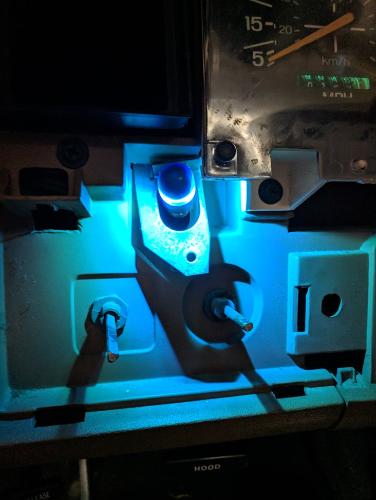
1985 F-350 XL | 460 | C6 | "Rufus Maximus"
1986 F-150|Standard Cab|4x2|300Six|C6Transmission w/3.08 rear|Name:TBD 2021 Ranger XLT Super Crew | Cactus Grey | black out package | max tow |
|
I had no intentions of replacing the doors on this truck but I ended up having too. These are from LMC truck. I am comforted that they come from a ISO 9001 certified company.
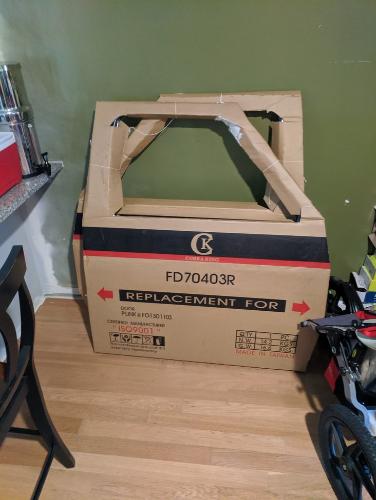 Even though the come "ready to paint" I cleaned them up scuffed them and primered them. This is my first time painting so this door was a good test bed for me to work on control, prep and finish. I wanted to make sure the door and the cab and jams were painted before it went together so when I do the outside, or if I decide I cannot paint well enough to do the outside everything will match if I pay someone.  and then painted single stage white. I had one fish eye on the bottom seam where no one will ever see but it came out good. I was unsure about white but now it is definitely growing on me. 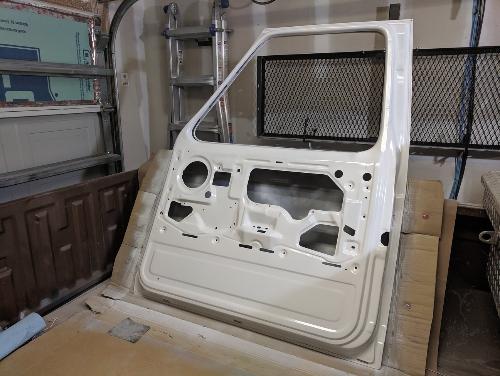 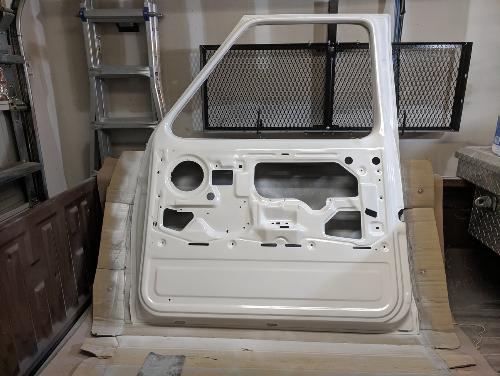 Moving to the cab, here is that door hinge. It is sprayed with Eastwoods rust treatment. That stuff is pricey but it goes on like a dream. I decided I would use this instead of corroseal on any other area that is going to get a final paint finish as brushing the corroseal is going to leave stroke marks that take a lot of time to turn out. 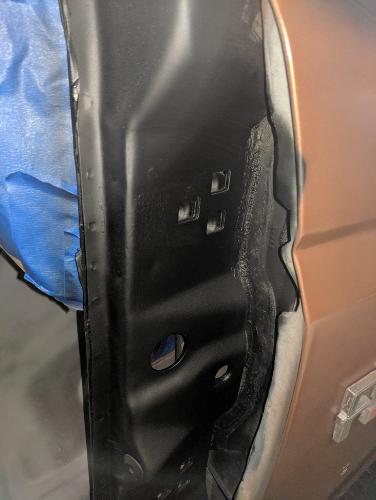 This is just the first coat of primer in the cab. I cant seem to find the picture but I did another coat and evened it all out and sanded it clean in the pictures where I start top coating you can see it, heck it almost blends in with the white. 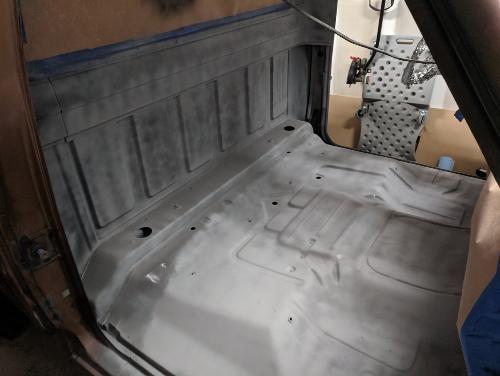 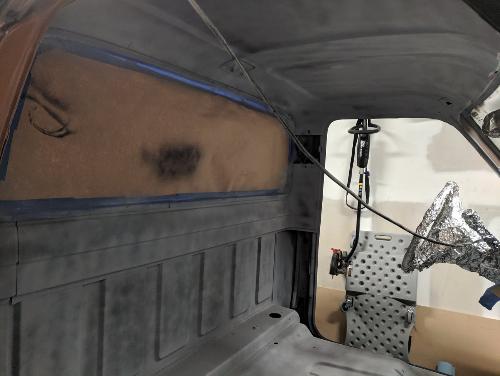 Time for paint!! Finally. I should note in my tiny garage in SC it is hot and humid, not conducive to paint. I bought a portable AC and ran a dryer vent in the wall and that didnt work out so I cut a hole in the house, installed a window and then at 12000 btu window AC. My garage is now workable. I didn't mask the windshield, its getting replaced. 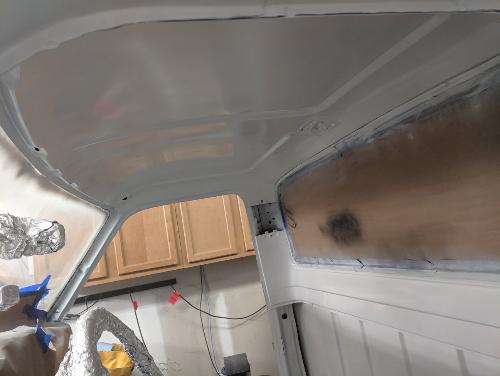 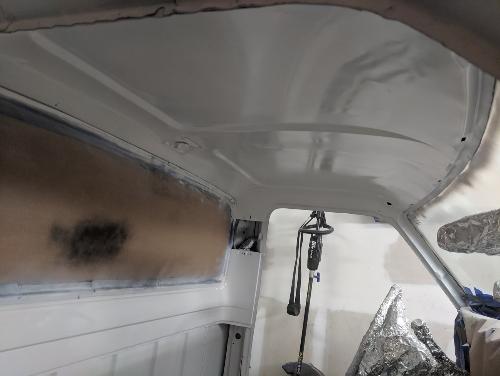 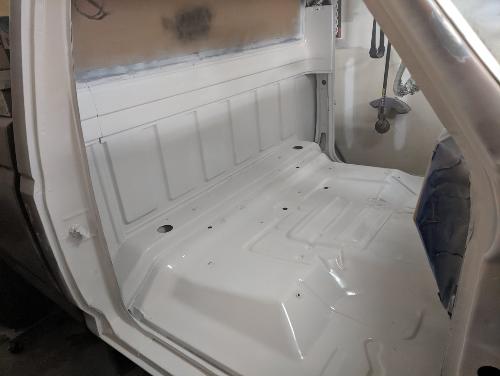 Working on this truck, definitely helps me connect with a piece of my grandfather and nostalgia from being a kid. My wife doesn't get it, it stresses her out but I can get lost in here for hours as an escape. Maybe I should have been a mechanic like him lol. My dad came to visit (they live in NY as does the rest of the family) and he was pretty excited, you could see him reminiscing and pointing out things that were "just like his" reminding him of the Bronco he had. Man if I had the money I would buy and restore an '86 Bronco for him.
1985 F-350 XL | 460 | C6 | "Rufus Maximus"
1986 F-150|Standard Cab|4x2|300Six|C6Transmission w/3.08 rear|Name:TBD 2021 Ranger XLT Super Crew | Cactus Grey | black out package | max tow |
|
In reply to this post by Danny G
OK Gary, this is the part you were asking about. Eva matting... what the crap is Eva matting.
Eva matting is an asphalt based heat barrier and sound deadening material that is by nature water proof. You can get it at LMC and Rock Auto. I got mine from Rock Auto (here by known as RA) for cheaper. The carpet, eva mat and jute/foil insulation are all made by ACC. The matting is pre cut to fit over your hump, and down in the foot box. You will need to order the material for your layout. I was not impressed with the "pre-cut to fit" fit. It is a bit hard to work with. What I ended up doing is cutting it into 6 pieces. Hump, drivers footbox, passenger footbox and 3 for under the seat. This gave me a couple benefits. I am installing it with Super 90 spray glue by 3M. If I spray this huge piece and try to get it down it may not sit right, and you will need someone on both sides of the cab to do it properly. Secondly it allowed me to position the peices for what I felt was the best fit and function. A good pair of scissors and a seam/carpet roller is a must. Also be sure your paint is cured before doing this. The 3M spray glue could cause fresh paint to peel.  You could stop here, or not even do this at all and install carpet, but I still have some PTSD from that first day driving home and how loud and cold the cab was. This process will significantly quiet noise from the drive train and road while also providing a good bit of environmental insulation, and on top of that, will also make any sound system that goes in sound that much better. Next step is the jute and foil insulation. This is like the carpet pad in your house. it is also cut for your vehicle with a separate piece for the hump. After you lay it in you will see where you need to make cuts to make it sit properly. Looking at this picture you will see where it bubbles on corners. Simply cut up or cut a narrow "v" to compensate Spray the eva mat/surface to attach it to AND the just underbelly of the insulation. Usually the time it takes to spray both sides is enough for it to tack up. It will instantly grab you mat for the most part. After it is in roll it with the carpet/seam roller to make sure it adheres to all the surfaces and is form fitting.  I worked this in pieces. Hump first, then passenger foot box, the driver foot box. You can fold it back to spray then put it back down. Then I folded the back half forward and started working that end. OH and do not forget to locate and cut out your holes before doing this. When all is said and done use 3m foil tape to secure the edges of the mat and the holes. This will keep it from fraying where you cut it and help with longevity. 
1985 F-350 XL | 460 | C6 | "Rufus Maximus"
1986 F-150|Standard Cab|4x2|300Six|C6Transmission w/3.08 rear|Name:TBD 2021 Ranger XLT Super Crew | Cactus Grey | black out package | max tow |
|
Just curious, but is this cab insulation done mostly for sound deadening purposes, or for insulating (heat) purposes?
1994 F150 4x2 Flareside. 5.0 w/MAF, 4R70W, stock.
1984 F150 4X2 Flareside. Mild 302 w/ 5spd. Sold. 1980 F150 4X4 Flareside. 300i6 w/ 5spd. Sold in 2021. 1980 F100 4X2 Flareside. 351w/2bbl w/NP435. Sold in 1995 |
Bullnose Enthusiasts Forum
›
Projects
|
1 view|%1 views
| Edit this page |

